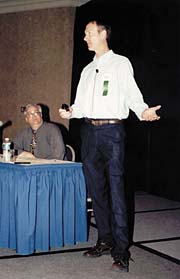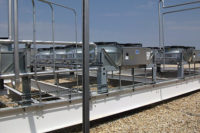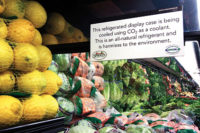That was the theme of the Food Management Institute’s (FMI’s) 23rd Annual Energy & Technical Services Conference. Sessions ranged from energy management to new refrigerants to the latest in equipment. There was also an underlying theme: Energy management, refrigerants, and equipment still can be used to cut operational costs of supermarkets, most of which operate on the thinnest of profit margins.

AIR RETURN CHOICES
Sometimes the selection of a method of air return is a matter of crunching numbers combined with real-world tests. That was the point made by two speakers.Ralph Pitzer, principal, GPM Engineering, Corpus Christi, TX, looked at three methods of air return — high, low, and under case — and came out strongly in favor of under case. The technology, he said, involves drawing the air underneath the refrigerated case and bringing it up through an air plenum above the case, then to a return air duct above the plenum.
Pitzer said he ran some calculations in a 73,000-square-foot supermarket. To run an HVAC system with high return, 144 tons of A/C would be needed. To run a floor-level return, he said 119 tons would be needed. An under-case return could require just 80 tons.
He added that the high and low units would need a nominal 50-HP motor, while the under-the-counter design would need a 40-HP motor.
“Insist that your designer take the refrigeration case into consideration,” he said. “Use the optimum return-air method.”
Lee Churchill, national sales manager for Seasons 4, Easthampton, NJ, took on the humidity issue and contended that lowering the setpoint from 58 to 50 degrees F can produce cost savings. He performed his research on 40,000-square-foot stores in Baltimore, MD, and Miami, FL. Even with the cost to “dry out the store in Miami,” savings can be realized, he said. He noted that humidity control is needed 90% of the year in Miami and 45% of the year in Baltimore.
His research showed that “If you try to dry beyond 50 degrees, costs rise. So, a 50 degree dewpoint is optimum.”
He added that engineers can look to lower operating costs by eliminating air filtration and positively pressurizing a store, which means “sealing cracks and using enough treated air.” He further encouraged upgrading to premium-efficiency motors.
“Remember,” he said, “your blower runs 24 hours a day.”
Another aspect to look at, he said, is the use of deep-row cooling coils. “Both sensible and latent capacities increase as the coil depth increases.”
R-410A IN REFRIGERATION?
R-410A has become the darling refrigerant of A/C manufacturers as a long-term alternative to the beloved (but doomed) R-22. But, can R-410A work in refrigeration applications?It is possible, said Warren Beeton, vice president of Refrigeration Engineering, Copeland Corp., Sidney, OH. He said research is under way to determine its viability. One area focuses on working with a 6-HP, vapor-injected (VI) scroll compressor.
“R-410A may offer added benefits with VI scrolls in close-coupled refrigeration systems vs. 404A,” he said.
There is a bit of irony in comparing 410A with 404A; 404A has long had a beachhead in the refrigeration sector as a long-term replacement for once-king R-502.
Much of the current work is preliminary, Beeton said. R-410A carries a higher heat transferability and pressure drop. Beeton said those issues can be addressed with equipment redesign. System efficiency can be 6% to 12% higher with R-410A, he added, along with a possible 25% refrigerant cost reduction vs. 404A.
SECONDARY LOOP
Secondary-loop technology has been an undercurrent for a half-dozen years in the supermarket industry. The intensity of its promotion by manufacturers has risen and fallen over the years, but it has yet to catch on with many supermarket equipment decision makers.Two proponents of the technology once again sang its praises at the conference. Their advocacy was not only based on being able to use less HFC refrigerant, but on the ability to expand the shelf life of fresh food products.
“Your real job is to sell food,” said Scott Martin, director for Advanced Engineering, Hill Phoenix, Conyers, GA. “Secondary loop extends the shelf life of food, especially meat.”
He cited a study where three cases were compared by storing the same types of meat in each. One was a secondary-loop case with a gravity coil and glycol. A second case used conventional direct expansion (DX) coils with humidification. The third was a DX unit with a gravity coil. The independent test gave highest marks to the secondary-loop unit.
Martin noted that reluctance in the supermarket industry to turn to secondary loops may be because most store engineers aren’t used to it. “It is a major mind shift to change from DX piping to fluid piping,” he said.
Kenneth Hauck, Refrigeration and HVAC Coordinator for Wegman’s Food Markets, headquartered in Rochester, NY, reported on a study of secondary loop compared with conventional DX systems. The basic tradeoff is a reduced HFC or HCFC charge vs. a higher cost of equipment and increased installation costs, in part due to the use of copper piping. Hauck also noted that energy costs run about 2% to 3% higher for secondary loops, even though most projections anticipate a 5% to 7% increase.
The side benefit of increased shelf life was shown in Hauck’s research. He noted in a store trial that “The produce [personnel] didn’t have to pull greens overnight and meats had an extra day of shelf life.”
He added, “We see a lot of benefits far out weighing the costs we experienced at the beginning.”
HFCS AND BEYOND
Strong support for the long-term viability of HFCs was presented by John Dieckmann, senior consultant for TIAX, Cambridge, MA. His advocacy came amidst efforts overseas to curtail use of those refrigerants.“Many players have called for restrictions and prohibition of HFCs used in many applications. But HFCs are generally safe, and lead to robust, cost-effective equipment,” Dieckmann said.
He also looked at ways the refrigerant can be used in supermarkets, citing conventional DX systems (“which are in 90% of supermarkets”), secondary-loop systems, and distributed systems that have a number of small mechanical systems rather than a large backroom rack.
One project was to plug in some statistics to see how such systems stacked up regarding Lifetime Climate Change Performance (LCCP), a variation on the Total Equivalent Warming Impact (TEWI) many nations use in the global warming issue. He noted an LCCP of 23.8 for DX systems with HFCs, 11.5 for distributed systems with HFCs, 13.8 for secondary loops with HFCs, and 13.6 for secondary loops with ammonia.
His main position: “When technical alternatives have similar TEWI or LCCP, let the market decide.”
ENERGY AWARENESS
Energy management begins with energy awareness. It was back to square one for one store chain in this regard, said Gary Kuchyt, energy manager, Big Y Foods, Springfield, MA.Faced with no energy management policy, no employee training on energy issues, and rising costs, the chain made an effort to establish a uniform policy.
“Store managers had to buy in, employees had to be aware of it and buy in. The idea was to make energy awareness a priority,” Kuchyt said. The process involved a lot of basic changes, such as establishing standard sets of temperatures for various areas of a store, assigning a management-level person to act as an energy monitor, and creating criteria such as not turning the pizza oven on until an hour before it needs to be used, not first thing in the morning.
Once a policy is started, how do you keep it going? That was the talk of Kathy Loftus, director, Energy and Environment Management, Shaw’s Supermarkets, East Bridgewater, MA. She called for a holistic approach “with a team of internal people, contractors, vendors, and consultants.”
Energy management “goes down to each circuit,” she said. The top 13 “offending” circuits are highlighted and translated into profit-and-loss numbers.
GETTING STAFF COMMITTED
While one HVACR person is struggling mightily to conserve energy, other store employees might not be as committed. Question: How do you get everyone on the same page? By giving them as much information as possible, said Paul Allen, chief engineer, Energy Management, Walt Disney World (WDW), Orlando, FL.He and one other person run the energy management system for the massive WDW complex. “I have to encourage everyone to save energy. I do that by showing them the data,” he said.
For Allen, being able to store and retrieve that information needs to be as simple and economical as possible, while still providing a myriad of details. He said he uses the Internet and is able to track information from his laptop.
The hardware and software are easily obtainable, he said. “Every-thing I show you today you can order on the Internet or get at Best Buy,” he said during a presentation that included live online demonstrations.
The communication involves daily information from thousands of checkpoints, which themselves use fairly simple technologies, Allen said. The information is pumped into data collection programs that in turn are put into relational databases that go to Web servers and the Web browser. “It is actually not too complicated for users familiar with Internet technology,” he said.
Finding simplicity amidst complexity is one of the strategies for a superefficient store, according to David Robinson, Bradenton, FL-based product group manager for Invensys. One aspect is to use “utility bills as the entry into energy information analysis. This is low tech and high return. Bills answer questions like, ‘Which is the most costly store?’”
Robinson suggested using an outside utility accounting service for multisite companies like supermarket chains. “In this way, we can get a concise view of bill data.”
The next step, he said, is to track data that shows how energy is used. “This,” he said, “covers real issues, especially in larger stores.” Another method is benchmarking, “which allows you to identify the best and worst performances” among similar stores.
For those who don’t want to deal with a deluge of data on a constant basis, one solution may be to outsource it. “Your purpose is to move food,” said Neal Starling, vice president, general manager, Emerson Retail, Kennesaw, GA. “Everything else is distracting.”
That’s why he calls for third-party oversight. Such services monitor individual pieces of equipment, as well as the total system. He said the need is partially due to changes going on in the industry, such as paperless maintenance and dispatching. “Out-sourced retail services can provide valuable benefits. A third party may help with scale and expertise and provide a nonbiased view.”
Robert Lewis, vice president, Sales/Marketing, Danfoss/ECI, Baltimore, MD, focused on what he calls “exception reporting.” This computer-based technology, he said, projects when a compressor may be failing or a fan belt may need tightening. It can also help store maintenance staff deal with refrigerant-loss issues.
But even with all the razzle-dazzle technology, maintenance gets down to the basics. “If you are going to send out for someone to take care of a problem, you’d better be sure it is a refrigeration mechanic.”
He also suggested that advanced technology extend to the equipment itself. He cited one study concerning a rack loaded with the latest in case controls and monitors while another rack with the same refrigeration capabilities had far fewer add-ons. The first model, Lewis said, was able to operate at an annual cost about 60% of the pared down unit. He suggested a payback of about two years for the upgrades.
UP ON THE ROOF
The roof of a supermarket has considerable impact on the overall energy efficiency of the store, according to Thomas Devers, principal of the Philadelphia firm Devers Architects. He urged the audience of supermarket engineers to be aware of the type of roof used, whether it is light or dark in color and what kind of insulation is used. “The roof is 75% of an exposed area of a building and gets 100% of the sun,” he said.Types of roofing have changed over the years, he said. Current popular choices, such as thermoplastics, need reinforcement for puncture resistance, but also probably shouldn’t have coatings added, he said. “Coatings won’t make a bad roof better. It won’t withstand pounding rain.”
A number of studies, he said, show that operating costs of buildings with white roofs are less than those of buildings with black roofs. But an even greater consideration, he said, is increasing the insulation of an existing roof.
Sidebar: EPA Official Revisits Regs, Urban Legends
BAL HARBOUR, FL — What has the Environmental Protection Agency (EPA) been up to these days?The FMI Energy & Technical Services Conference here hosted a seminar on “Re-examining Clean Air Compliance Regulations and Refrigerant Phaseout.” Julius Banks, an EPA program manager in the National Recycling and Emissions Reduction sector, touched on frequently asked questions, rumors, and urban legends concerning the EPA.
— Peter Powell

Sidebar: Supermarkets May See Radical Ways To Provide Refrigeration
BAL HARBOUR, FL — Super-market mechanicals are familiar to contractors and technicians. Most often, the systems consist of racks of compressors and components in back rooms. Recent variations have included secondary loops (where a glycol or brine is used to reduce charges of HCFCs or HFCs) and distributed systems (in which the back room is done away with and mini compressor racks are placed throughout the store).The ways in which stores receive power also undergo constant, sometimes confusing changes. Figuring out rates and rebates is complicated by occasional problems with the delivery of power.
That’s why some people constantly look for different ways of doing things — even if the ideas fall into the “Now For Something Completely Different” category.
In the talking/experimental stages for supermarkets are lithium bromide absorption chillers, ammonia-and-water heat pumps, microturbines, and fuel cells.
Two presenters at the Food Marketing Institute Energy & Technical Services Conference peered into the future.
“I’m not trying to sell you today,” said Richard Sweetser, president, Exergy Partners, Herndon, VA. “We are looking at how to get somewhere five years down the road.”
He reviewed several supermarket projects under way. While not yet cost effective, he said one purpose of the projects was to cope with increasing worldwide power demands as the population grows and Third World countries become industrialized.
“We have to create new power sources,” he said. “We are not going to do this [with current power sources] or we will suck the well dry.”
He noted a project at a supermarket in Hauppauge, NY, where both desiccant dehumidification and a 60-kW gas turbine are used. The desiccant included hot water coils and the turbine had a natural gas scroll compressor.
A San Antonio, TX, project has an 80-kW microturbine in a lithium bromide chiller. Sweetser said such equipment is designed to provide uniform usage and curtail peaks and valleys.
Also on the drawing board is a microturbine with liquid refrigerant subcooling.
The attention to microturbines was expanded upon by Jim Kesseli, Portsmouth, NH-director of Advanced Sciences, Ingersoll-Rand Energy Systems. Like Sweetser, Kesseli noted much work needs to be done with the technology. In theory, such a unit has a long life (80,000 hours of operation for one unit discussed), needs little maintenance (8,000 hours of operation between service calls for the same unit), and has high efficiency.
For supermarkets, Kesseli said, “Microturbines can be used as a backup should the conventional power grid go down.” He added that it is a “very green” product, a political plus for store owners with buildings often near housing developments.
“The current market challenge is first cost,” he said. “The goal is to have a two-and-a-half- to three-year payback.”
He noted that with microturbines:
— Peter Powell
Publication date: 10/07/2002






